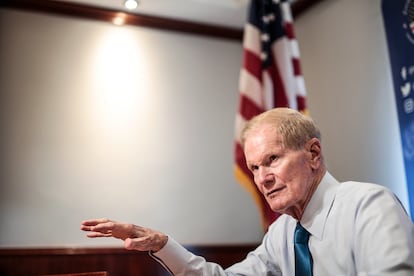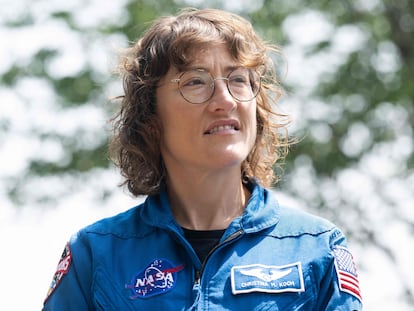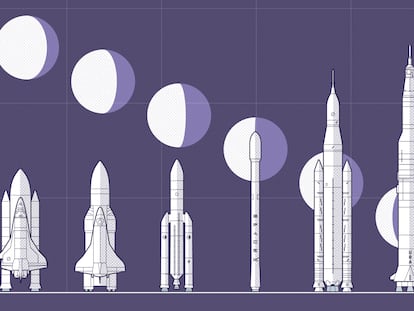Bill Nelson, head of NASA: ‘We want to protect the water on the Moon to prevent China from taking it over’
The administrator of the U.S. space agency traveled to Madrid to sign the ‘Artemis’ agreements with Spain’s Minister of Science Diana Morant and meet with Prime Minister Pedro Sánchez

Bill Nelson is a former Democratic senator, astronaut, and present administrator of the U.S. space agency (NASA). The American is visiting Madrid because Spain has just become the 25th signatory of the Artemis agreements, the political framework for cooperation that will lay the groundwork for peaceful exploration of the Moon and other celestial bodies in the coming decades. After meeting with Spanish Prime Minister Pedro Sánchez at the Moncloa Palace, and signing the document with the Minister of Science Diana Morant, Nelson gave a joint interview to EL PAÍS and El Mundo at the U.S. Embassy.
Question: What are the Artemis agreements, and how will they benefit Spain?
Answer: These are common sense principles, such as peaceful uses of space, coming together to help each other in times of danger and having cooperative parts, so that if you had to come to somebody’s rescue, the spacecraft would have compatible docking systems. It also rules out that someone could reach the moon and claim territory and so prevent others from accessing it. And here I’m thinking of China and what it did in the Spratly Islands in the South China Sea. This territory was in international waters, and China came and claimed it for their own; they started building airstrips. We want to prevent this kind of thing and that is why 25 countries have already signed up and there will probably be many more soon.
Q. You specifically mentioned China, which is progressing very fast in space and aims to be the world’s largest space power by 2045. Who do you think will win this new space race?
A. China has also just announced that it will send astronauts to the Moon in 2030. We are in a new space race. If we are lucky, we will be the first to land on the moon in half a century, in 2025 or 2026. That crew will include the first woman to set foot on the moon, and the next man. In subsequent missions, a crew of four members will all step onto the surface and stay there for up to 300 days. But there’s a lot that’s got to happen between now and then, and China may actually be planning to get there sooner.
Q. Are they likely to overtake you?
A. I think the United States will get there first. What worries me more is that both they and we are going to land at the South Pole, where we think there is water. In fact, we are going to land a robotic instrument in this area this year and another one that will dig for water next year. We believe there is because we see ice in rock crevices that are permanently shadowed. Water is important because it is composed of oxygen and hydrogen, and that’s oxygen to breathe and hydrogen for rocket fuel. We want to preserve those potential reserves for the international community, and prevent China from coming in and saying that the water is theirs, as they have done with the Spratly Islands.

Q. Will these agreements also limit the exploitation of resources by private companies?
A. We do not know what resources are available. But I think the important thing is also whether there are resources beyond the moon, maybe on an asteroid. Is there an asteroid that might have titanium or precious metals? But with regard to the moon, we’re going to the moon for a different reason. We went there 50 years ago. Now it’s about going to learn to live, work, create and invent, so that we can send humans to Mars someday. It takes only three or four days to go to the moon, but going to Mars takes seven, eight months and once you get there you have to stay on the surface for one or two years before the planet comes back into alignment with the Earth and you can return. This is why habitats must be developed. You also need to be able to get there faster. We are researching new propulsion systems for this so we can make the trip in three months, stay on the surface for a week and come back. We think the earliest we can get to Mars is 2040. It seems like a lot, but it’s only 17 years.
Q. A few weeks ago, the Starship rocket that is to carry astronauts to the Moon exploded due to a malfunction. Do you think this failure will delay plans to land on the moon in 2025 or 2026?
A. I hope SpaceX has the spacecraft ready. True, they had an explosion, but that’s their modus operandi. They have a lot of rockets. This last one they launched soared for several minutes. There were eight engines that failed to ignite and then exploded. They have now learned why and have fixed it for the next launch and so will be making progress. This is not the way NASA works. We try to be perfect, although we do not always succeed, as witnessed by terrible accidents such as Apollo 1 or the space shuttle Challenger, which exploded killing seven crew members, just ten days after I myself returned to Earth from space in 1986. We also lost another crew of seven in the Columbia disaster in 2003. These were human errors that should never have happened. SpaceX, on the other hand, launches rocket after rocket until it works. That’s what they did with the Falcon 9 reusable rocket, which has been a huge success.
Q. The Artemis 2 crew is already set: three Americans and one Canadian. Is there any chance of a European on Artemis 3?
A. I can’t tell you if there will be a European in the four-person crew, but only two will set foot on the Moon: a woman and a man. It’s been 50 years. They will be Americans. In future missions, all four crew members will set foot on the Moon.
Q. Is there any specific field in which Spain can make important contributions in the return to the Moon?
A. Spain already makes a crucial contribution: the deep space network and one of its antennae, which is in Madrid. We would not have made it to the moon without it. Now the problem is that there are so many missions that the network is getting very crowded. So much so that during Artemis 1 we had to discard a lot of valuable data sent by the James Webb Space Telescope. We are now developing a faster form of communication based on lasers in addition to radio waves.

Q. What will happen with Russia’s collaboration on the International Space Station (ISS)?
A. My prediction is that the Russians will stay until we de-orbit the station. I think Russia is committed because after all we built the station together. The ISS is as big as a soccer field. It is certain that some parts will survive re-entry into the atmosphere, so we want to send it to a graveyard located in the Southern Pacific Ocean. We have to be very precise so that it does not cause damage or pose a danger to people. Although for now the Russians have said they will stay until 2028, I believe they will continue until 2030, which is the date we will de-orbit the station. Just a year ago the head of the Russian space agency said they were withdrawing immediately. He was fired. The new boss is very professional.
Q. Earlier you mentioned the James Webb Telescope, which is NASA’s current major scientific project, what will be the next?
A. We are already planning a new one. But the Webb is so good that it is likely to last another 20 years. So, we will be able to go to it, refill its fuel, and it will be able to stay in use much longer. Then there will be other telescopes that will help us look specifically for exoplanets with life. In 2028, we will also launch NEO Surveyor. Its goal is to discover an asteroid that could impact the Earth causing severe damage, but is too small for us to see with other telescopes. If you recall, the recent DART mission successfully diverted an asteroid. So if we are successful, we will be able to see a killer asteroid coming and deflect it just enough to miss us.
Q. How is NASA dealing with the threat of climate change?
A. NASA is also a climate agency, and we have many satellites studying this aspect. We will soon launch four new satellites that will give us a three-dimensional view of what is happening with the climate on land, in the seas, in the ice and in the atmosphere. And by the way, it’s hard for me to say the word atmosphere without telling you what I saw out the window of a spacecraft when I flew. You look at the rim of the earth, and you see this thin film, and you suddenly realize that’s everything that sustains our life. It’s so thin, and we’re messing it up down on the face of the earth.
Peaceful exploration without space junk
The Artemis agreements lay the groundwork for cooperation in the future exploration of the Moon, in particular the U.S.-led Artemis project, in collaboration with the space agencies of Europe, Canada and Japan, to take the first woman and the first non-white man (both Americans) to the surface of the Moon in 2025; and to build a space station in orbit of the Moon in 2025. The agreement includes fundamental principles such as transparency and mutual assistance in case the astronauts need rescue.
The eight original signatories to the treaty were the United States, Italy, Canada, Japan, Luxembourg, the United Kingdom, Australia and the United Arab Emirates in October 2020. Since then, 17 other countries in Africa, the Americas, Asia and Europe, including Spain, have joined.
The Artemis agreements fall within the framework of the United Nations space treaty which states, among other things, that no country can claim nationality over any territory on the Moon or any other celestial body. The document signed today also provides for the sharing of scientific information collected by each country, although it leaves private companies out of this framework, unless they operate on behalf of one of the signatory countries. The text provides for the extraction of natural resources on the Moon and other bodies and the signatories undertake to inform the United Nations of their plans.
The Artemis framework also obliges signatories to limit space debris and take responsibility for the removal of satellites and other end-of-life spacecraft.
Sign up for our weekly newsletter to get more English-language news coverage from EL PAÍS USA Edition
Tu suscripción se está usando en otro dispositivo
¿Quieres añadir otro usuario a tu suscripción?
Si continúas leyendo en este dispositivo, no se podrá leer en el otro.
FlechaTu suscripción se está usando en otro dispositivo y solo puedes acceder a EL PAÍS desde un dispositivo a la vez.
Si quieres compartir tu cuenta, cambia tu suscripción a la modalidad Premium, así podrás añadir otro usuario. Cada uno accederá con su propia cuenta de email, lo que os permitirá personalizar vuestra experiencia en EL PAÍS.
¿Tienes una suscripción de empresa? Accede aquí para contratar más cuentas.
En el caso de no saber quién está usando tu cuenta, te recomendamos cambiar tu contraseña aquí.
Si decides continuar compartiendo tu cuenta, este mensaje se mostrará en tu dispositivo y en el de la otra persona que está usando tu cuenta de forma indefinida, afectando a tu experiencia de lectura. Puedes consultar aquí los términos y condiciones de la suscripción digital.
More information
Archived In
Últimas noticias
Rowan Atkinson tops Netflix at 70: ‘He’s as funny as ever’
Israeli recognition of Somaliland stirs up the Gulf
Tiger Woods turns 50: Will he continue playing on the PGA Tour or take a back seat?
The surreal journey of James Nnaji, the Barcelona youth player selected in the NBA Draft who ended up in the NCAA
Most viewed
- Oona Chaplin: ‘I told James Cameron that I was living in a treehouse and starting a permaculture project with a friend’
- Reinhard Genzel, Nobel laureate in physics: ‘One-minute videos will never give you the truth’
- Sinaloa Cartel war is taking its toll on Los Chapitos
- Why the price of coffee has skyrocketed: from Brazilian plantations to specialty coffee houses
- Chevy Chase, the beloved comedian who was a monster off camera: ‘Not everyone hated him, just the people who’ve worked with him’











































